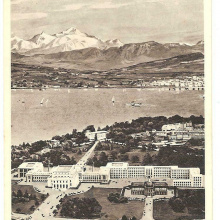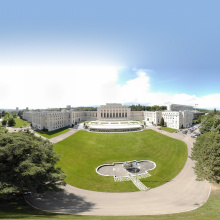L’Office des Nations Unies à Genève (ONUG), installé dans l’historique Palais des Nations, est le deuxième plus grand centre des Nations Unies, après le siège des Nations Unies à New York. L’établissement est un témoignage exceptionnel de l’architecture du XXe siècle. Il est situé dans le magnifique parc Ariana à Genève, en Suisse.
Le Palais des Nations est l’un des plus grands centres de conférences diplomatiques au monde. Quelque 8 000 réunions sont organisées chaque année. La plupart des salles de conférence datent de la construction originale du Palais des Nations dans les années 1930.
HISTORY OF THE PALAIS




The League of Nations, known as the predecessor of the United Nations, initially established its Secretariat in the Hôtel National building, today known as Palais Wilson, along the shores of Lake Geneva. During the extraordinary session held in 1926 to discuss Germany’s admission to the League, the Assembly approved an international architectural competition for the construction of the Palais des Nations, the future home of the League of Nations.
In 1927, 377 architectural projects were submitted to the League of Nations. As it was impossible to reach a unanimous agreement on a single submission, five architects were appointed to work on a common project: Julien Flegenheimer of Switzerland, Camille Lefèvre and Henri-Paul Nénot of France, Carlo Broggi of Italy and József Vágó of Hungary. Though not included in the original design, a library was incorporated into the architectural project, thanks to a US $2 million donation from John D. Rockefeller Jr.
With the inclusion of a library, the League of Nations needed to find a larger parcel of land than originally planned along the shores of Lake Geneva. Ultimately, through an exchange with the City of Geneva, the Palais found its home in the 46-hectare Ariana Park. The Park had been bequeathed to the City of Geneva by Gustave Revilliod upon his death in 1890, as the last descendent of the Revilliod de la Rive family.
Built in the art deco style of the times, the foundation stone of the Palais was ceremoniously laid in Ariana Park on 7 September 1929. Beneath the stone is a casket containing a list of the League of Nations Member States, a copy of the Covenant of the League and coins of all the countries represented at its Tenth Assembly. The League of Nations moved its headquarters to the Palais des Nations in 1936.
Though dissolved at a final Assembly held in Geneva in April 1946, the League of Nations handed over its properties and assets to the United Nations Organization, the Palais des Nations being its crown jewel. While the headquarters of the new Organization was established in New York, the European Office of the United Nations was created in the Palais des Nations.
